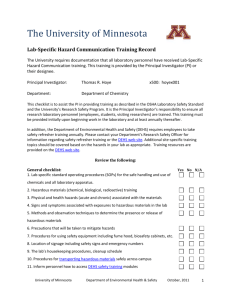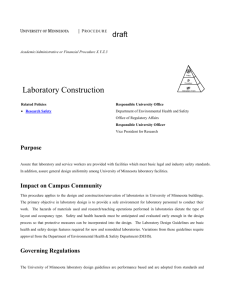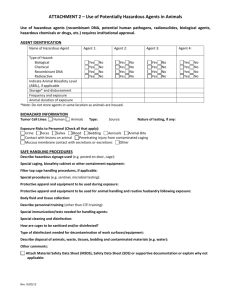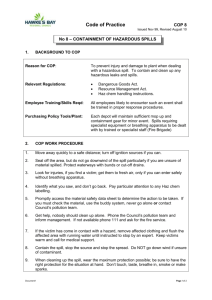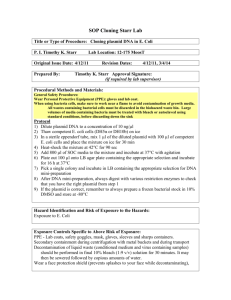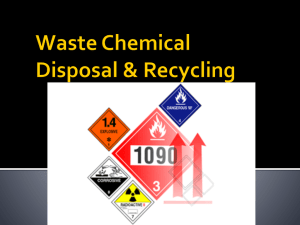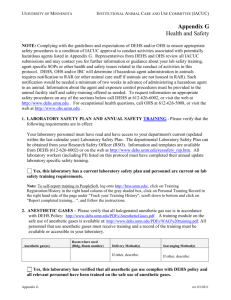Lab Specific Training Checklist - the Department of Environmental
advertisement
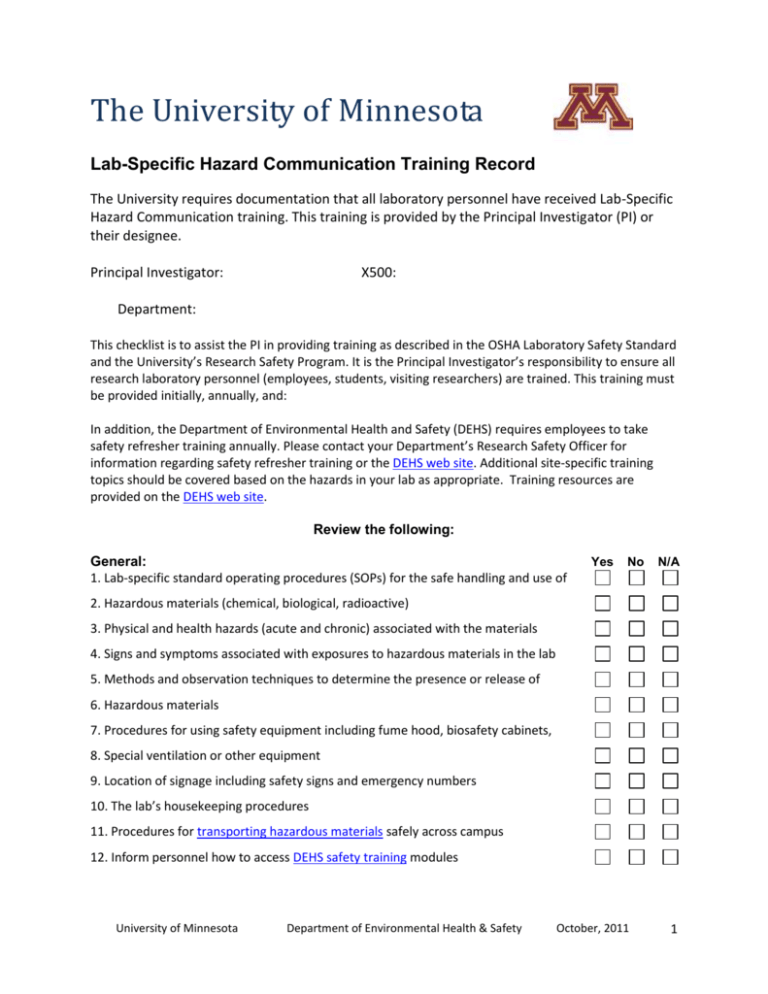
The University of Minnesota Lab-Specific Hazard Communication Training Record The University requires documentation that all laboratory personnel have received Lab-Specific Hazard Communication training. This training is provided by the Principal Investigator (PI) or their designee. Principal Investigator: X500: Department: This checklist is to assist the PI in providing training as described in the OSHA Laboratory Safety Standard and the University’s Research Safety Program. It is the Principal Investigator’s responsibility to ensure all research laboratory personnel (employees, students, visiting researchers) are trained. This training must be provided initially, annually, and: In addition, the Department of Environmental Health and Safety (DEHS) requires employees to take safety refresher training annually. Please contact your Department’s Research Safety Officer for information regarding safety refresher training or the DEHS web site. Additional site-specific training topics should be covered based on the hazards in your lab as appropriate. Training resources are provided on the DEHS web site. Review the following: General: 1. Lab-specific standard operating procedures (SOPs) for the safe handling and use of Yes No N/A 2. Hazardous materials (chemical, biological, radioactive) 3. Physical and health hazards (acute and chronic) associated with the materials 4. Signs and symptoms associated with exposures to hazardous materials in the lab 5. Methods and observation techniques to determine the presence or release of 6. Hazardous materials 7. Procedures for using safety equipment including fume hood, biosafety cabinets, 8. Special ventilation or other equipment 9. Location of signage including safety signs and emergency numbers 10. The lab’s housekeeping procedures 11. Procedures for transporting hazardous materials safely across campus 12. Inform personnel how to access DEHS safety training modules University of Minnesota Department of Environmental Health & Safety October, 2011 1 Chemicals: 1. Storage location of chemicals and their segregation by compatibility Yes No N/A Yes No N/A Yes No N/A Yes No N/A 2. Requirements for chemical labeling on primary and secondary containers 3. Use, storage, and handling of gas cylinders and cryogenics 4. Use of specific chemicals that would warrant exposure monitoring 5. Chemical waste program information Biological: 1. Biosafety Manual and Exposure Control Plan Policies and Procedures 2. Decontamination and disinfection procedures 3. Biological Decontamination & Spill Clean-up Plan Template 4. Biohazards and Toxin Decontamination & Spill Clean-up Radioactive: 1. General requirements (posting, training, security) 2. Food and beverage prohibition 3. Proper laboratory attire (Lab Safety Plan) see also PPE below 4. Contamination surveys and instrumentation 5. Radioisotope spills and emergencies 6. Permit Holder responsibilities 7. Radioisotope purchasing and transfer 8. Radioactive waste management/disposal 9. GM operation and survey protocol 10. Record keeping requirements 11. Personnel monitoring and dosimetry 12. Prenatal exposure guide 13. ALARA considerations Equipment: 1. Autoclave use and safety training 2. Hand washing sink 3. Biological Safety Cabinet use and training 4. Safe use of chemical fume hoods University of Minnesota Department of Environmental Health & Safety October, 2011 2 Personal Protective Equipment (PPE): 1. PPE requirements for personnel including selection, maintenance and use Yes No N/A Yes No N/A Yes No N/A Yes No N/A Yes No N/A 2. How personnel can obtain PPE and how to dispose of after use Emergency Response: 1 .Handling incidents in the lab including exposures, needle sticks and applying first aid 2. Location of emergency equipment including spill kits, fire extinguishers and alarms 3. Emergency shut-offs, eyewashes, and safety showers 4. Emergency procedures including evacuations and spill clean-up (contact DEHS) 5. How to contact Occupational Health in the event of an injury Waste: 1. Processes and locations for proper waste disposal in your department 2. How to request and safely dispose of chemical, biological, and radioactive waste 3. Procedures for disposal of highly toxic chemicals, carcinogens or chemotherapeutics 4. Correctly labeling and storing hazardous waste and waste containers 5. How to adequately clean-up or sanitize your lab equipment and work areas Documentation: 1. Location of Material Safety Data Sheets and lab-specific SOPs 2. Copy of the current Departmental Laboratory Safety Plan 3. Location of Training Records for all laboratory personnel 4. Incident report forms 5. Hazardous Waste Guidebook, Radiation Protection Manual and Biosafety Manual 6. Recent laboratory inspections and self evaluations Occupational Health: 1. Occupational Health requirements 2. How to get vaccinated, medically evaluated, or fitted for respiratory protection 3. Location and contact information for the Occupational Health Clinic University of Minnesota Department of Environmental Health & Safety October, 2011 3 Additional Site Specific Topics: (Describe any additional topics covered during the training.) Certification: In accordance with the OSHA Laboratory Safety Standard and the University’s Research Safety Program, the individuals listed below have attended a training session covering the topics in this training checklist. Name X500 Date I certify that the topics indicated on this training checklist were covered (as applicable) in this training session. Instructor: x500: Date of training: Location of Training: University of Minnesota Department of Environmental Health & Safety October, 2011 4
